2019 Alfa Romeo Stelvio Quadrifoglio Review | Heck of a third impression
https://ift.tt/2WoTyFJ
The 2019 Alfa Romeo Stelvio Quadrifoglio does not make a good second impression. The first impression? A-OK, as you approach its distinctive Alfa face, admire its tight proportions and wonder why someone would paint it something other than Alfa Rosso. It’s so definitely not German, which counts for a lot should you live in a neighborhood where everyone drives a black BMW or silver Audi. That this Stelvio costs $94,340 seems steep, but at least it has the looks to back it up.
Then you pull the door handle and the action is eerily reminiscent of a Dodge Dart. The door opens and the sound and feel are just a bit hollow. You sit down inside and press a button, any button, or turn a knob. The plastic feels cheap and the action is flimsy. It’s basically the exact opposite of what you get in an Audi or Porsche. Even their touch-sensitive controls emit a hearty click. Car journalists may go on about “soft-touch materials” in cars, but it’s the switchgear that one ultimately interacts most with. If the volume knob feels Fisher-Price, who cares that the dash and just about every other interior surface is covered in leather?
To be fair, the Alfa’s cabin is indeed covered as such, and since this is the Quadrifoglio, it gets green and white stitching with carbon fiber trim. It certainly doesn’t look cheap, even if it definitely feels it and sounds like it given the duo of distinctive rattles that had already developed in a press car with a mere 3,400 miles on it.
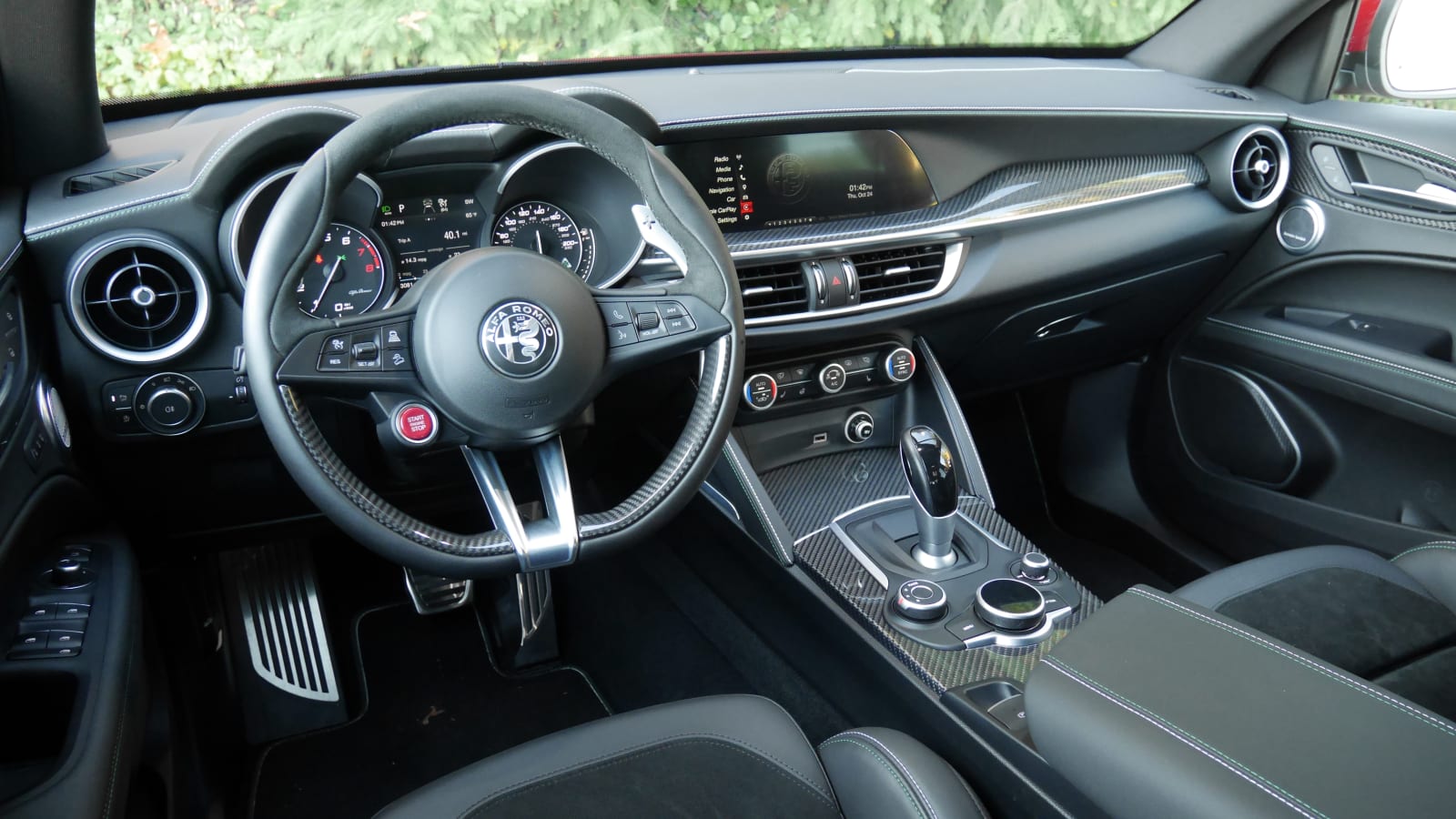
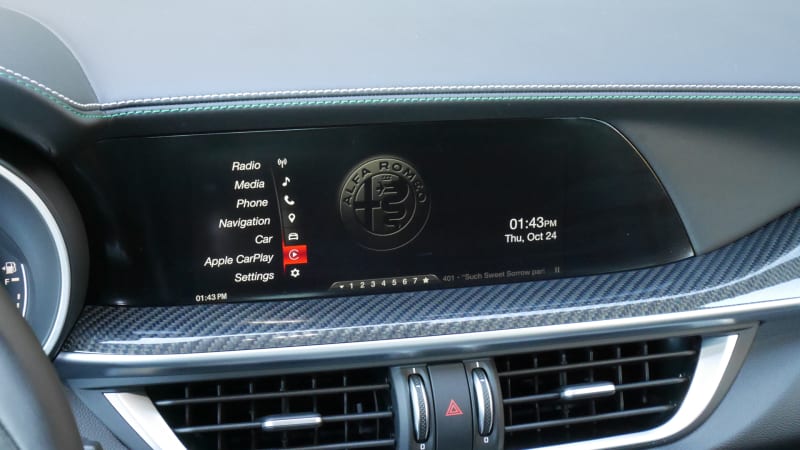
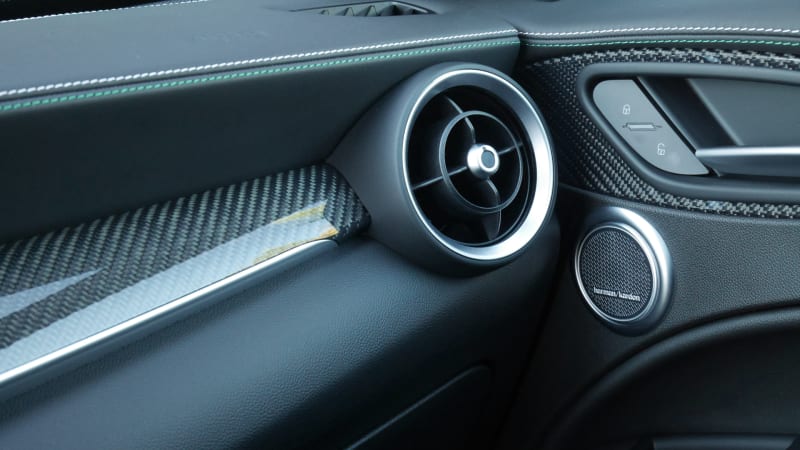
There’s also the infotainment system, which is highlighted by an 8.8-inch screen that doesn’t take good advantage of its sizeable real estate. There’s a control knob with accompanying Menu and Option buttons. It’s better than Lexus Remote Touch, but that’s a bar previously used at a corgi agility competition. Rival systems are easier to use (not to mention FCA’s own Uconnect touchscreen) and appear more state-of-the-art (because they are).
It’s very possible that a prospective luxury SUV shopper would stop right there, never even bothering to go on a test drive. If they’d just come from a Porsche, Audi or BMW store, it’s particularly easy to see that happening.
Of course, it’s the test drive where the Alfa Romeo Stelvio Quadrifoglio makes its third and best impression. It’s as sizzling and wild as you might have heard. The delicacy and immediacy of the controls are immediately noticed. Associate Editor Zac Palmer recently described the Porsche Cayenne’s steering as “lightning-quick.” If that’s so, the Stelvio’s is light speed. I was expecting it, but someone used to a slower SUV rack might immediately veer into a curb. The fact that it’s so beautifully light in effort and friction-free combines to provide the most precise and rewarding steering of any SUV I’ve ever driven. The effort differences between the three “DNA” driving modes (“d” is for dynamic, “n” for natural/normal and “a” for advanced efficiency) seems negligible at first as you make your way up to the sportiest “d” for dynamic, but when you come back down after hauling along at speed for a while, you do notice there’s just a little bit of play in “n” mode. Basically, well done, Alfa. Also, even if the steering is quick, that lighter effort also makes it plenty easy to operate a slow speeds.
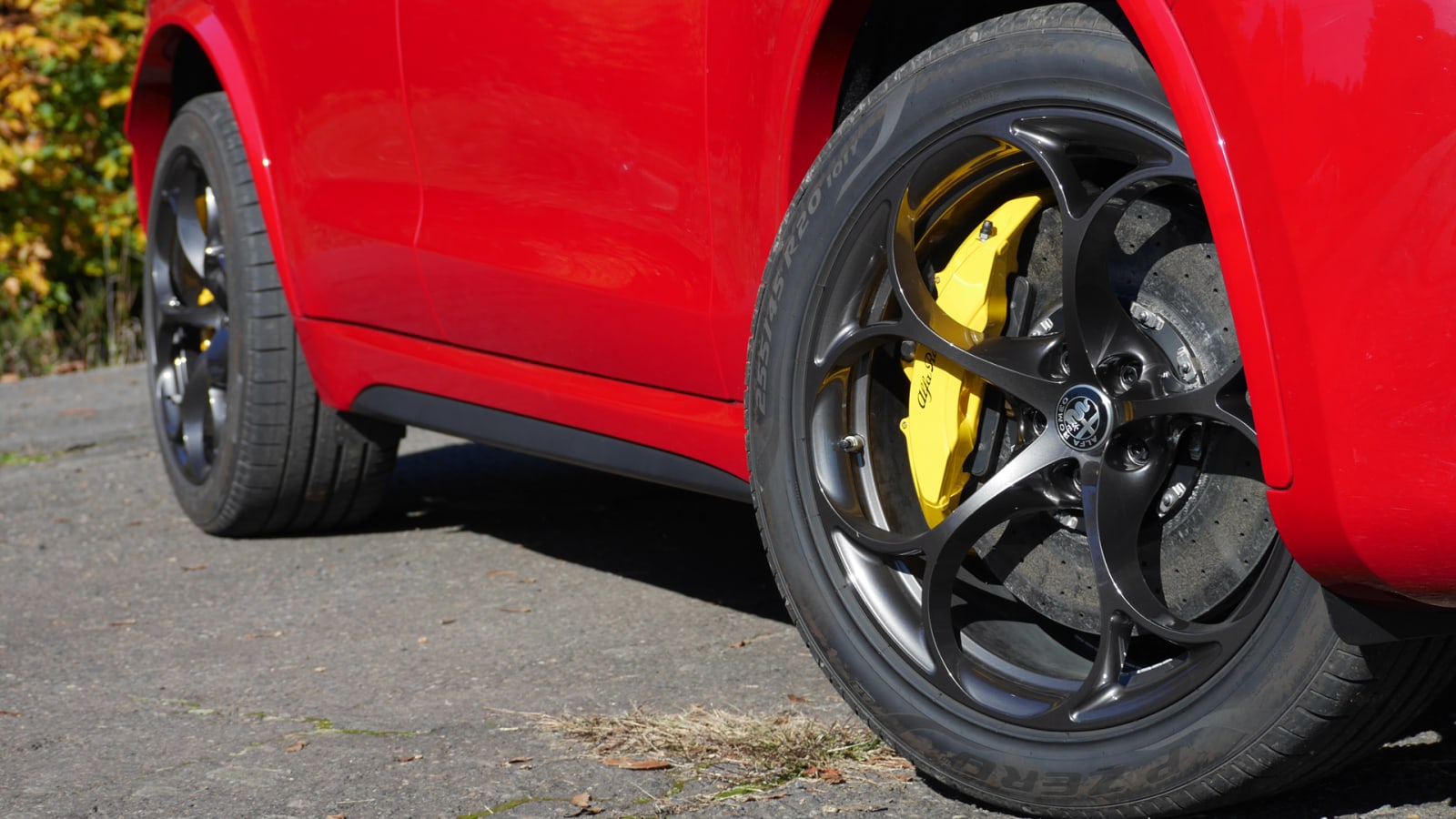
The brakes similarly have a right-now biting action that encourages the deliberate inputs of a mindful driver, but rewards with a firm action and easy modulation. The test car wore $8,000 carbon-ceramic brakes, however, so I can’t say how much of a difference they play in terms of pedal action and feel.
Nevertheless, the brake pedal itself is perfectly positioned to be a nice, short, easy pivot away from the accelerator. Actually, there are probably those who’d think it was far too close. They probably owned a Buick at some point, but it should at least be noted that wearing work boots may not be the best idea.
The accelerator is similarly activated by a relative feather touch, even in its most lethargic “a” mode. It results in some unusual, slightly jerky behavior at low speeds, which negates some of the around-town drivability gained by the steering. On the other hand, this feather touch also rewards a driver who likes being fully in control of their car. Selecting “d” kicks things up a notch further, but the Stelvio never feels over-caffeinated or twitchy when driven at speed. Revs aren’t hung onto unnecessarily, for instance, but much as our editors in Michigan recently discovered in a Giulia Quadrifoglio, Alfa’s ZF-sourced eight-speed automatic could react more sharply to braking and downshift further in anticipation of getting back on the gas soon thereafter. Not surprisingly, the least zesty driving element, the transmission, actually hails from Germany.
The engine most definitely does not, for the 2.9-liter twin-turbocharged V6 is blessed with Ferrari DNA. It produces 505 horsepower, fires you forth with decadent speed and sings a song exponentially more characterful than anything else in this segment with a turbocharger. And it’s really the engine, too, not faked stereo noises nor overt exhaust histrionics. Oh, the exhaust certainly lets out a fun blat when upshifting in “d” mode, but it’s not contrived.
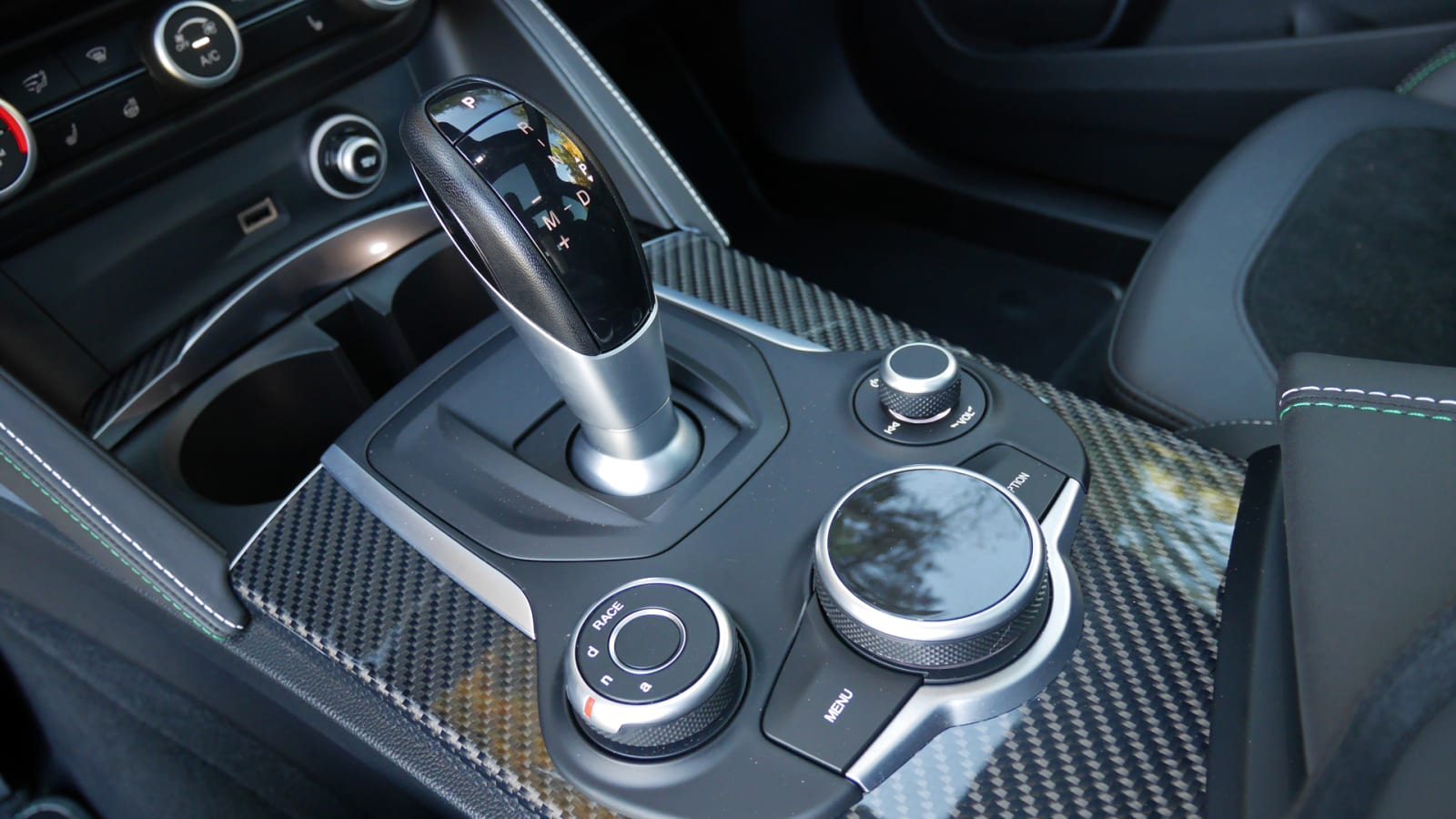
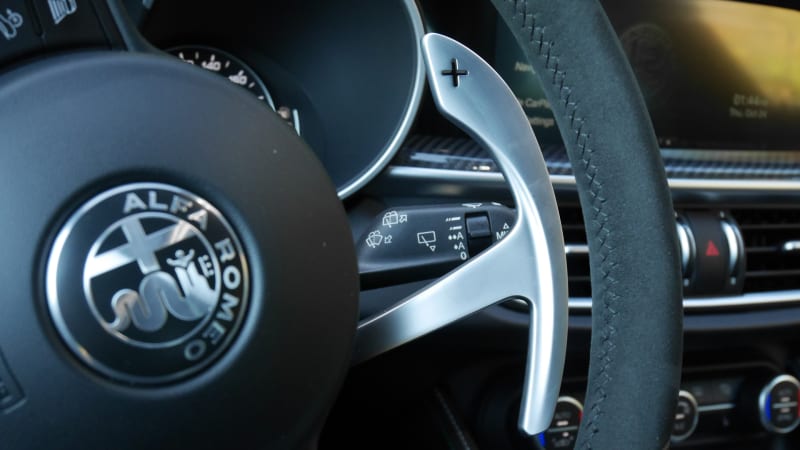

Putting that power down is an all-wheel-drive system that clearly isn’t as clever as those utilized by others. There isn’t that same resolute whip feeling around corners, as power is moved about to create a tank-like turning effect. There’s just a hint of understeer in tight hairpins, and the traction control retards power, rather than the all-wheel-drive system using it as an advantage. Porsche and Audi’s systems do a better job of smartly moving power about in a way that allows the car to defy the laws of physics without drawing your attention to its wizardry.
Those cars are positively clinical by comparison to the Alfa, though. We recently tested a Cayenne Turbo fitted with every performance upgrade under the sun, and although I suspect it would be quicker around a track, never did that stunning achievement of speed and physics-defying ever delight in the same way as the Stelvio does. You hear more and you feel more — both tactilely and emotionally.
Road holding is exceptional, and whoever thought of including a Soft Suspension button for the “d” mode was a genius. It allows you to quickly soften the springs when driving on bumpy pavement that can upset the car’s chassis or your spine. That ability itself is not unique, but the interface is — no need to dig into menus, just press an easily accessed button.
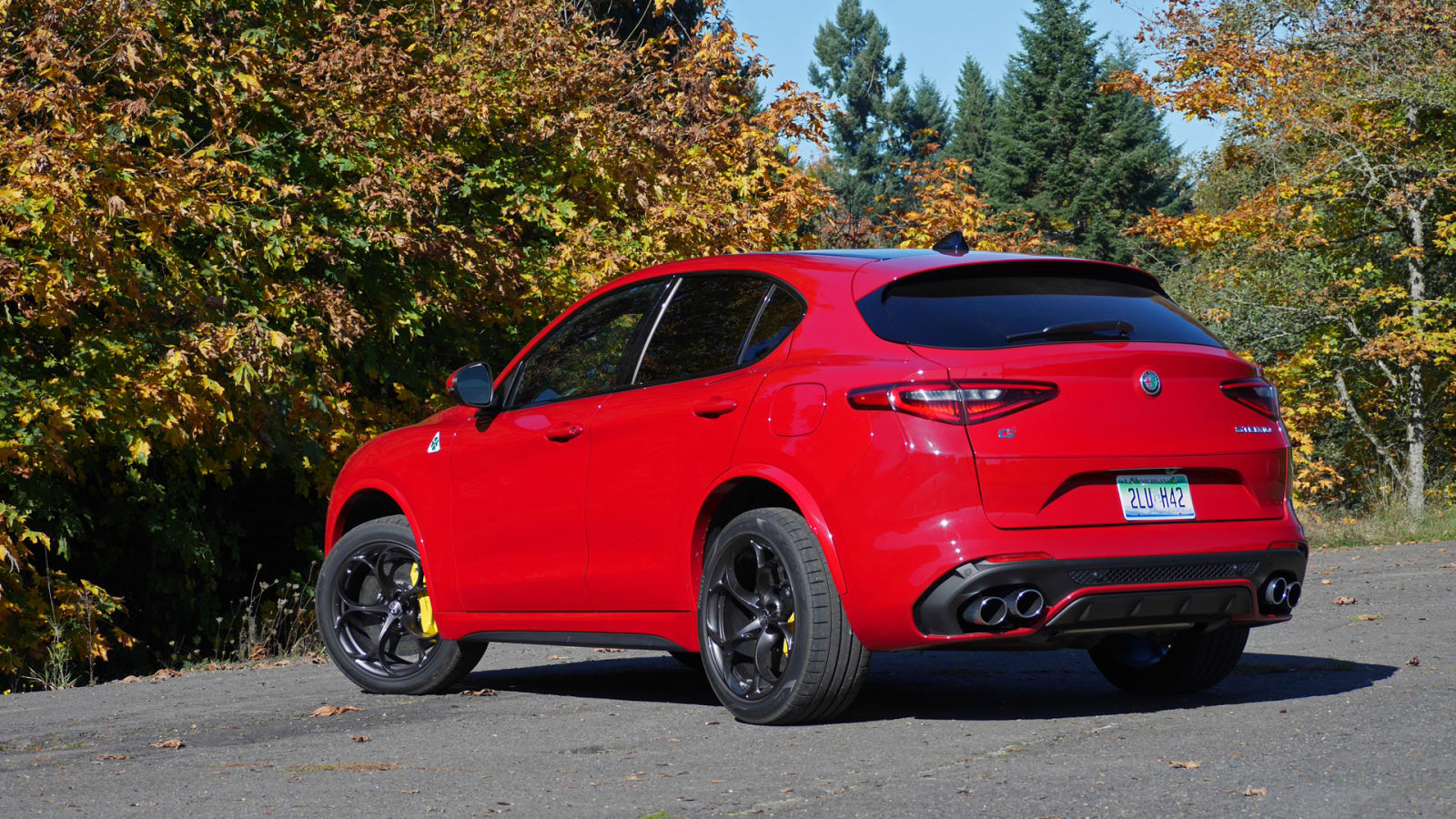
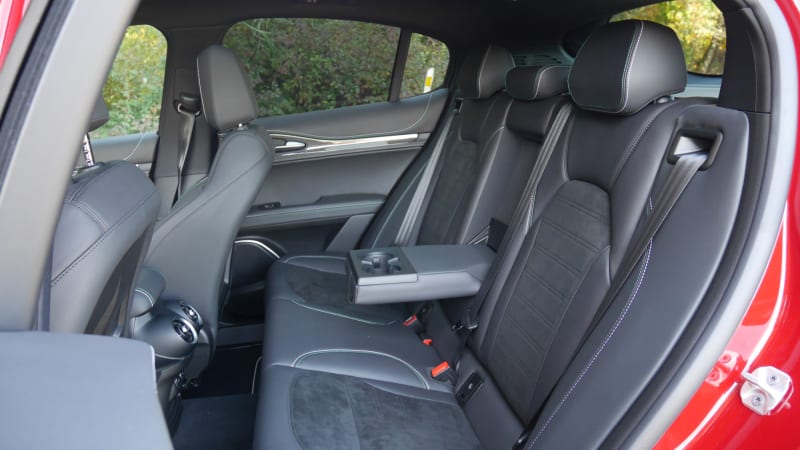
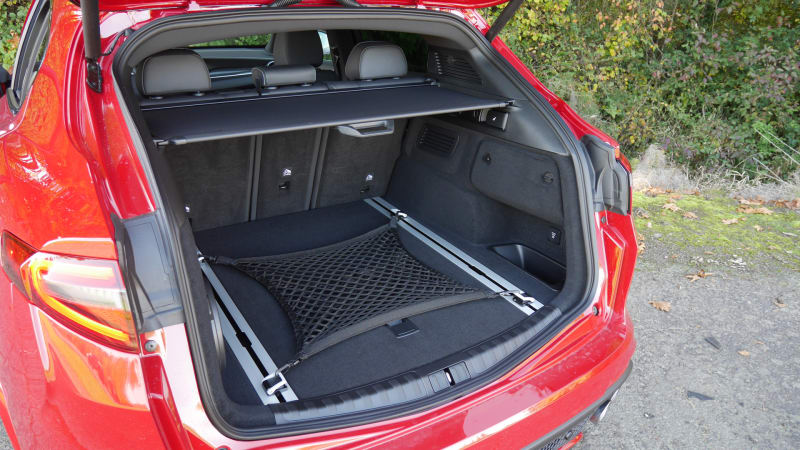
When in the fully softer “n” and “a” modes, the Stelvio’s ride is certainly on the firm side, but it’s never crashy nor tiresome over potholes and big bumps. That said, the interior’s propensity for rattles is bound to be exasperated by the ride. Other practical matters: interior space. A full luggage test is coming soon, but — spoiler alert — all my bags could fit behind the raised back seat, which can lower by pulling handles in the cargo area as well as in the rear footwell. Clever. Rear passenger legroom seems typical for a compact SUV, but be warned that the $1,350 dual-pane sunroof seriously restricts headroom. Skip it.
Yet, despite its poor second impression, the four-leafed Alfa Romeo Stelvio would be very hard to skip. That Cayenne Turbo had a sticker of about $150,000, and despite all its go-fast add-ons, I can say definitively that I enjoyed driving the Alfa more. Of course, the Stelvio’s closer competitor is the Macan Turbo. When closely equipped to our $94,340 Alfa tester, the Porsche would basically be $100,000 and you’d still be leaving any number of options on the table. From a performance and driving perspective, I’d still take the Stelvio.
Alas, there is more to a car than just performance and a zesty mountain road experience. The Porsches are still plenty thrilling, and they don’t make you wince when you open a door or press a button. It would be very hard to put down that much money on something with the Stelvio’s interior and unimpressive build quality. That said, this entire treatise on the 2019 Stelvio can be considered a preview of sorts for what’s coming in a few weeks: our first drive of the 2020 Alfa Romeo Stelvio, which apparently has “an enhanced premium interior, advanced safety features and new infotainment display with state-of-the-art connectivity.” I’ll be driving it in Italy. We’ll see if it makes a stronger second impression.
Auto Blog
via Autoblog https://ift.tt/1afPJWx
October 30, 2019 at 11:13AM